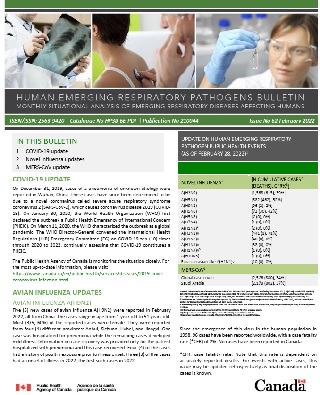Human emerging respiratory pathogens bulletin: Issue 62, February 2022
Download in PDF format
(1.1 MB, 3 pages)
Organization: Public Health Agency of Canada
Date published: 2022-03-08
Monthly situational analysis of emerging respiratory diseases affecting humans (data to February 28, 2022)
In this bulletin
- COVID-2019 update
- Avian influenza updates
- Swine influenza updates
- Middle East respiratory syndrome coronavirus (MERS-CoV) update
- In-depth Analysis: Avian influenza A(H5N6)
| Novel influenza Footnote 1 | Cumulative Case Count Footnote 2 | Deaths | Case Fatality Rate % Footnote 3 |
|---|---|---|---|
| A(H7N9) | 1,568 | 615 | 39% |
| A(H5N1) | 882 | 462 | 52% |
| A(H9N2) | 96 | 2 | 2% |
| A(H5N6) | 72 | 30 | 42% |
| A(H5N8) | 7 | 0 | 0% |
| A(H7N4) | 1 | 0 | 0% |
| A(H1N2) Footnote 4 | 2 | 0 | 0% |
| A(H3N2)v | 441 | 1 | <1% |
| A(H1N2)v | 40 | 0 | 0% |
| A(H1N1)v | 38 | 0 | 0% |
| A(H1NX)v Footnote 5 | 1 | 0 | 0 |
| A(H10N3) | 1 | 0 | 0% |
| Eurasian avian-like A(H1N1) | 10 | 0 | 0% |
| MERS-CoV Footnote 1 | Cumulative Case Count Footnote 2 | Deaths | Case Fatality Rate % Footnote 3 |
| Global Case Count | 2,576 | 880 | 34% |
| Saudi Arabia | 2,178 | 802 | 37% |
|
|||
COVID-19 update
On December 31, 2019, cases of a pneumonia of unknown etiology were reported in Wuhan, China. These cases have since been determined to be due to a novel coronavirus called severe acute respiratory syndrome coronavirus 2 (SARS-CoV-2), which causes coronavirus disease 2019 (COVID-19). On January 30, 2020, the World Health Organization (WHO) first declared the outbreak a Public Health Emergency of International Concern (PHEIC). On March 11, 2020, the WHO characterized the outbreak as a global pandemic. The WHO Director-General convened the International Health Regulations (IHR) Emergency Committee (EC) on COVID-19 ten (10) times through 2020 to 2022, continually assessing that COVID-19 constitutes a PHEIC.
The Public Health Agency of Canada is monitoring the situation closely.
Avian influenza updates
Avian influenza A(H9N2)
Five (5) new cases of avian influenza A(H9N2) were reported in February 2022, all from China. The cases range in age from 1 year old to 51 years old. Most (3/5; 60%) of the reported cases were female. They were reported from four (4) different provinces: Anhui, Sichuan, Hubei, and Jiangxi. One case was hospitalized for pneumonia while the remaining cases developed mild illness. Information on case recovery was provided only for the patient hospitalized with pneumonia and this case recovered. Four (4) of the cases had a history of poultry exposure prior to illness onset. Three (3) of the cases had an onset of illness in 2022, the first such cases in 2022.
Since the emergence of this virus in the human population in 1998, 96 cases have been reported worldwide, with a case fatality rate (*CFR) of 2%. No cases have been reported in Canada.
*CFR: case fatality rate. Note that this rate is dependent on accurately reported deaths. For events with active cases, this value may be updated retrospectively as final disposition of the cases is known.
Avian influenza A(H5N6)
Six (6) human cases of avian influenza A(H5N6) were reported in February 2022. They all reported contact with poultry prior to illness onset. The median age of these cases was 40.5 years (age range: 6-50 years) and most (5/6; 83%) of the reported cases were male. One (1) death was reported and the rest of the cases (5/6; 83%) were in critical condition at the time of last report. These 6 cases were detected across four (4) different regions in China: Jiangsu Province, Guangxi Zhuang Autonomous Region, Sichuan Province, and Fujian Province. None of the cases were known to be connected to each other or to previously reported cases.
A total of 72 laboratory-confirmed human cases of avian influenza A(H5N6), including at least 30 deaths (CFR: 42%) have been reported globally since 2014. Since January 2021, 46 cases of avian influenza A(H5N6) have been reported globally (Figure 2); 45 A(H5N6) cases were reported from China and one (1) case was reported from Lao People’s Democratic Republic (Figure 3). So far, 14 A(H5N6) cases have been reported worldwide in 2022. No cases have been reported in Canadian residents.
Avian influenza A(H5N1)
The most recent case of avian influenza A(H5N1) was reported in January 2022 from the United Kingdom.
There have been 882 human cases of A(H5N1) reported globally since 1997, with a CFR of 52%. One (1) A(H5N1) case has been reported worldwide in 2022. In 2014, Canada (Alberta) reported one single fatal case of A(H5N1) in a resident returning from travel in China.
Swine influenza updates
Swine origin influenza A(H1N2)v
In February 2022, the US Centers for Disease Control and Prevention (CDC) reported one (1) new A(H1N2)v case in California. The case, ≥18 years of age, was not hospitalized and has recovered from their illness. The case had direct contact with swine prior to illness onset. Respiratory illness was reported among contacts of the case, however no specimens from these contacts were received for testing. No ongoing human-to-human transmission was identified in association with this case.
A total of 40 A(H1N2)v cases have been reported globally since 2005, with a 0% case fatality rate. One (1) A(H1N2)v case has been reported worldwide in 2022. Three (3) A(H1N2)v detections have been reported in Canadian residents since reporting began in 2005, and the latest case in Canada was reported in November 2021 from Manitoba.
Swine origin influenza A(H3N2)v
The most recent case of swine origin influenza A(H3N2)v was reported in October 2021 from the US.
Globally, 441 A(H3N2)v cases have been reported since 2005, with <1% case fatality rate. No A(H3N2)v cases have been reported worldwide in 2022. Two (2) A(H3N2)v detections have been reported in Canadian residents since reporting began in 2005, with the latest case reported in June 2021.
Swine origin influenza A(H1N1)v
The most recent case of swine origin influenza A(H1N1)v was reported in January 2022 from Denmark.
Globally, 38 human cases of A(H1N1)v have been reported since 2005, with no associated fatalities. One (1) A(H1N1)v case has been reported worldwide in 2022. Two (2) A(H1N1)v detections have been reported in Canadian residents since reporting began in 2005, with the latest case reported in April 2021.
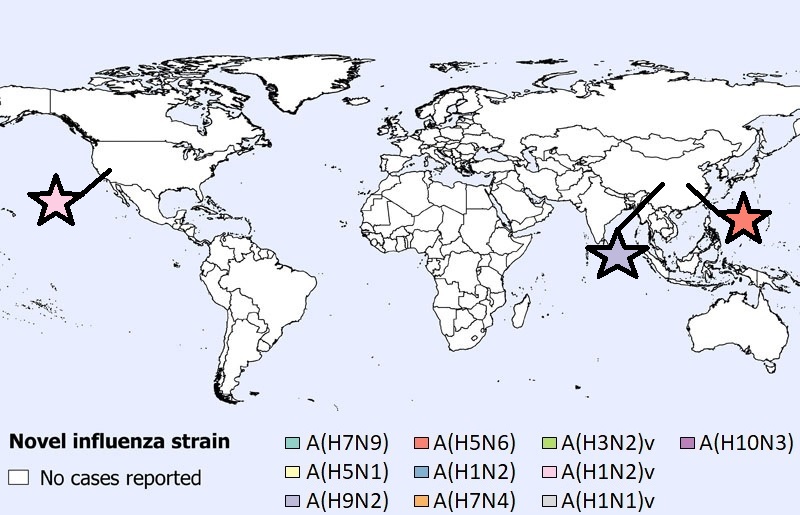
Note: Map was prepared by the Centre for Immunization and Respiratory Infectious Diseases (CIRID) using data from the latest WHO Event Information Site (EIS) postings and Weekly US Influenza Surveillance Reports (FluView). This map reflects data available through these publications as of February 28, 2022.
Figure 1 - Text equivalent
- Six A(H5N6) cases were reported in China.
- Five A(H9N2) cases were reported in China.
- One A(H1N2)v case was reported in the United States of America.
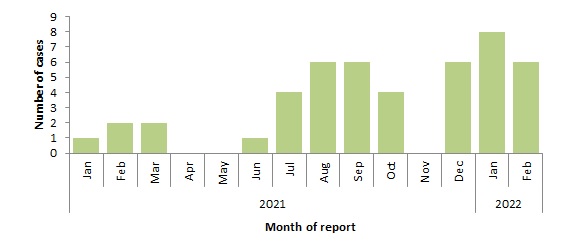
Note: Graph was prepared by the Centre for Immunization and Respiratory Infectious Diseases (CIRID) using data from the WHO EIS postings and the Hong Kong Centre for Health Protection (CHP) press releases. This graph reflects data available as of February 28, 2022.
Figure 2 - Text equivalent
| Month | Cases | |
|---|---|---|
| 2021 | Jan | 1 |
| Feb | 2 | |
| Mar | 2 | |
| Apr | 0 | |
| May | 0 | |
| June | 1 | |
| July | 4 | |
| Aug | 6 | |
| Sep | 6 | |
| Oct | 4 | |
| Nov | 0 | |
| Dec | 6 | |
| 2022 | Jan | 8 |
| Feb | 6 |
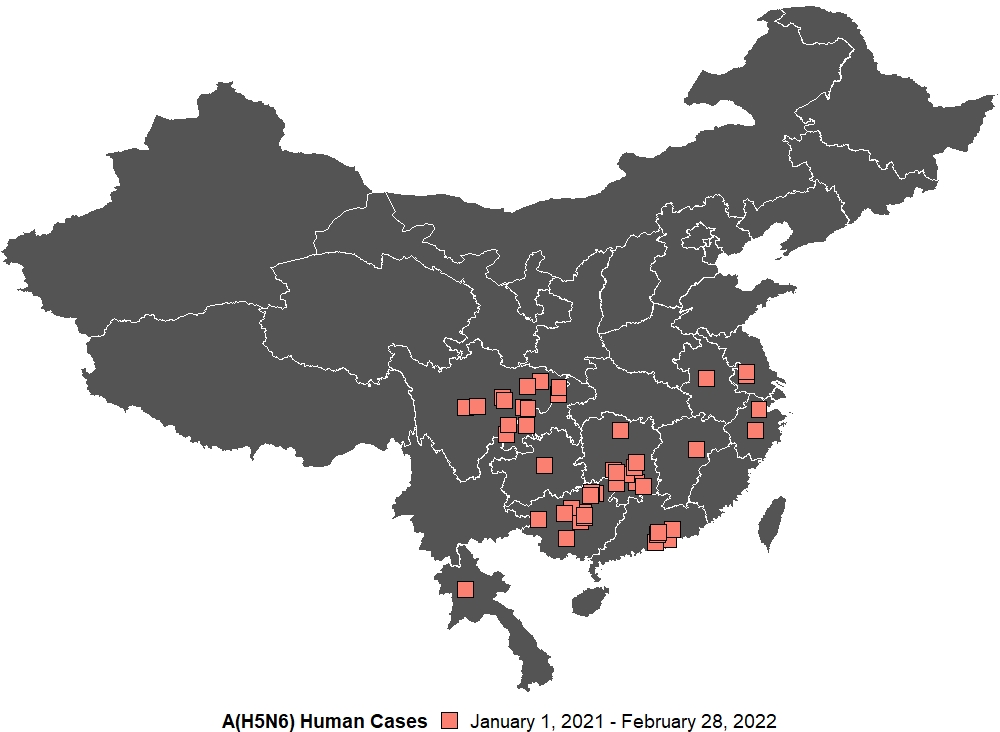
Note: Map was prepared by the Centre for Immunization and Respiratory Infectious Diseases (CIRID) using data from the WHO EIS postings and the Hong Kong Centre for Health Protection (CHP) press releases. This map reflects data available through these publications as of February 28, 2022.
Figure 3 - Text equivalent
- One case was reported out of Yongchuan, Chongqing Municipality.
- One case was reported out of Guizhou Province.
- One case was reported out of Anhui Province.
- Two cases were reported out of Guangxi Zhuang Autonomous Region.
- Two case was reported out of Chengdu, Sichuan Province.
- One case was reported out of Bazhong, Sichuan Province.
- One case was reported out of Kaijiang, Sichuan Province.
- Two cases were reported out of Tongnan, Chongqing Municipality.
- One case was reported out of Xuanhan, Sichuan Province.
- Three cases were reported out of Guilin, Guangxi Zhuang Autonomous Region.
- One case was reported out of Yibin, Sichuan Province.
- Two cases were reported out of Huizhou, Guangdong Province.
- Two cases were repored out of Dongguan, Guangdong Province.
- One case was reported out of Laibin, Guangxi Zhuang Autonomous Region.
- Two cases were reported out of Chenzhou, Hunan Province.
- Four cases were reported out of Yongzhou, Hunan Province.
- One case was reported out of Changde, Hunan Province.
- One case was reported out of Zigong, Sichuan Province.
- One case was reported out of Nanning, Guangxi Zhuang Autonomous Region.
- Two cases were reported out of Hengyang, Hunan Province.
- One case was reported out of Baise, Guangxi Zhuang Autonomous Region.
- One case was reported out of Zhenjiang, Jiangsu Province.
- One case was reported out of Fuzhou, Fujian Province.
- One case was reported out of Yangzhou, Jiangsu Province.
- One case was reported out of Hechi, Guangxi Zhuang Autonomous Region.
Middle East respiratory syndrome coronavirus (MERS-CoV) update
The most recent cases of MERS-CoV were reported in December 2021 from the Kingdom of Saudi Arabia.
A total of 2,576 laboratory-confirmed cases of MERS-CoV, including 880 deaths, have been reported globally since 2012 by the WHO (CFR: 34%). No MERS-CoV cases have been reported worldwide in 2022. No cases have been reported in Canada.
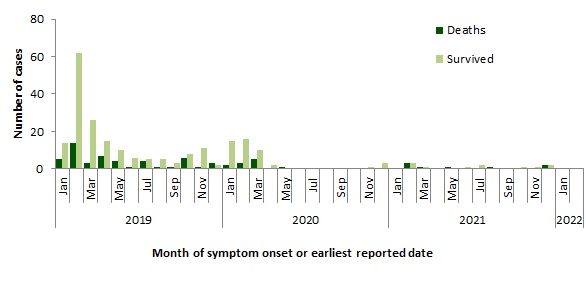
Note: Graph was prepared by the Centre for Immunization and Respiratory Infectious Diseases (CIRID) using data from the WHO Disease Outbreak News and Saudi Arabia’s Ministry of Health. This graph reflects data available as of February 28, 2022.
Figure 4 - Text equivalent
| Date | Deaths | Survived | |
|---|---|---|---|
| 2019 | Jan | 5 | 14 |
| Feb | 14 | 62 | |
| Mar | 3 | 26 | |
| Apr | 7 | 15 | |
| May | 4 | 10 | |
| June | 1 | 6 | |
| July | 4 | 5 | |
| Aug | 1 | 5 | |
| Sep | 1 | 3 | |
| Oct | 6 | 8 | |
| Nov | 1 | 11 | |
| Dec | 3 | 2 | |
| 2020 | Jan | 2 | 15 |
| Feb | 3 | 16 | |
| Mar | 5 | 10 | |
| Apr | 0 | 2 | |
| May | 1 | 0 | |
| June | 0 | 0 | |
| July | 0 | 0 | |
| Aug | 0 | 0 | |
| Sep | 0 | 0 | |
| Oct | 0 | 0 | |
| Nov | 0 | 1 | |
| Dec | 0 | 3 | |
| 2021 | Jan | 0 | 0 |
| Feb | 3 | 3 | |
| Mar | 1 | 1 | |
| Apr | 0 | 0 | |
| May | 1 | 0 | |
| June | 0 | 1 | |
| July | 0 | 2 | |
| Aug | 1 | 0 | |
| Sep | 0 | 0 | |
| Oct | 0 | 1 | |
| Nov | 0 | 1 | |
| Dec | 2 | 2 | |
| 2022 | Jan | 0 | 0 |
| Feb | 0 | 0 | |
